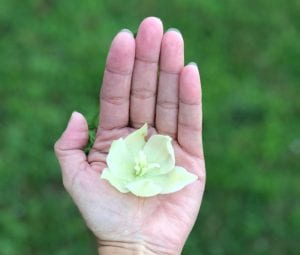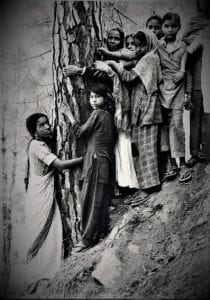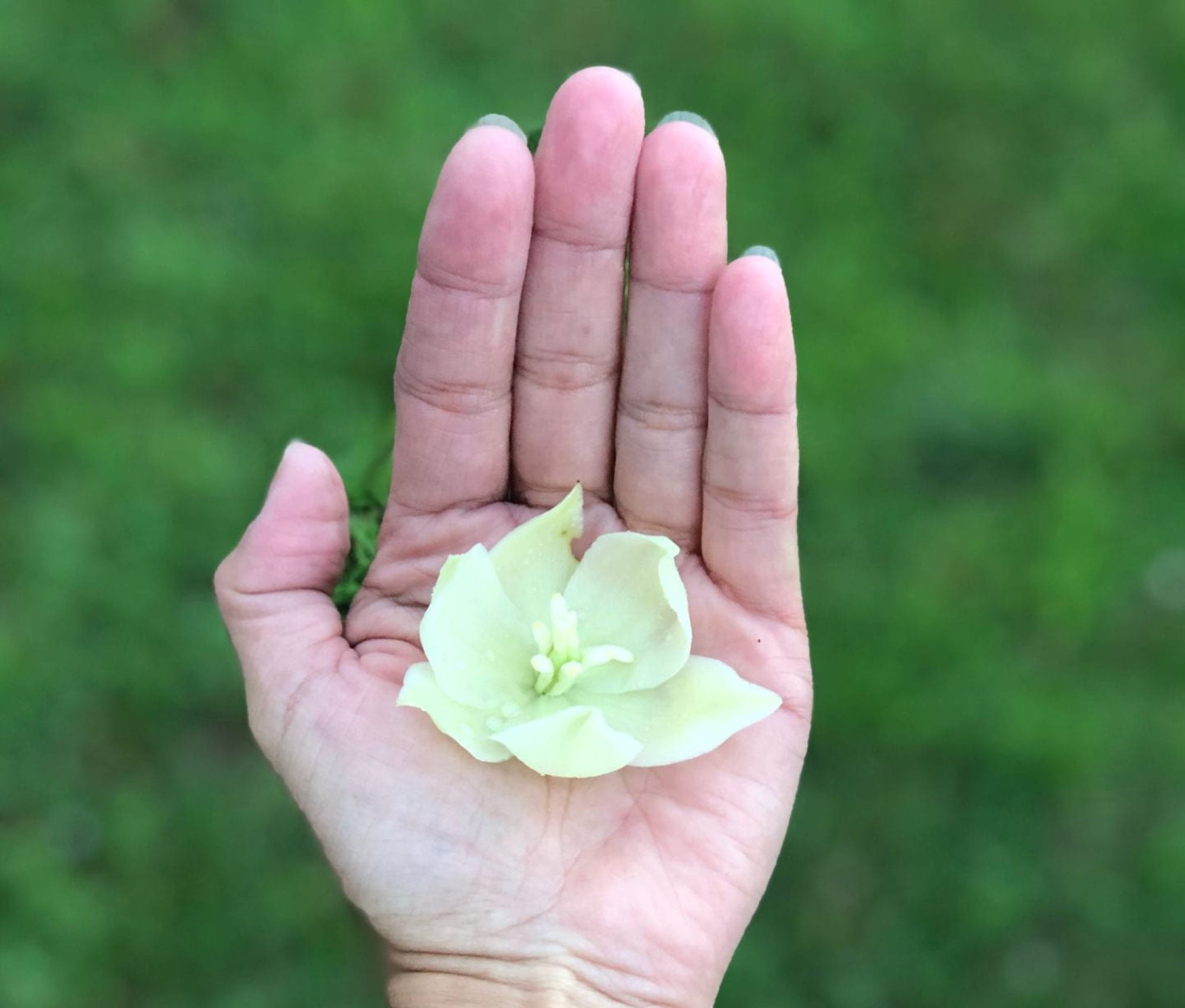
Photo by Rose Costa
From an ecofeminism perspective, this image of a female hand holding a small delicate flower in its palm may be interpreted as a symbol of the interconnectedness and interdependence between women and nature. The image suggests that women have a nurturing and protective relationship with the natural world, just as the hand is gently holding and caring for the flower. The delicate flower in the palm of the hand may also symbolize the fragility and vulnerability of both women and the environment, emphasizing the need for care and protection. From this perspective, the image may also be seen as a call to action in environmental activism and conservation efforts.
Ecofeminism, as described by Laura Hobgood-Oster in her 2002 essay Ecofeminism: Historic and International Evolution, “asserts that all forms of oppression are connected and that structures of oppression must be addressed in their totality” (1). That is, oppression of the natural world and of women by patriarchal power structures must be examined together or neither can be fully confronted. Although ecofeminism is a multidimensional movement that encompasses diverse perspectives and strategies, it is essentially rooted on the understanding that the oppression of women and the destruction of nature are connected and mutually reinforcing.
The main theory of ecofeminism is that the natural environment, often referred to as Mother Earth, is not just a passive backdrop to human activity but is a living entity that experiences “the tyranny of patriarchy along with women” (Hobgood-Oster, 2) and other marginalized groups. This idea is rooted in the belief that patriarchal systems of power and domination “through categorical or dualistic hierarchies … exist as an integral component of societal structuring and justification … [and] continue to serve as starting points to justify patriarchy” (Hobgood-Oster, 2-3). These systems which prioritize the interests of men and human society over those of women and the natural world, have led to the widespread degradation of the environment and the exploitation of non-human species. By recognizing and challenging the interrelation of these systems of oppression, ecofeminists hope to create a more equitable and sustainable society for all living beings.
The exploitation of natural resources in marginalized communities, often for the benefit of more privileged groups, is seen as both a form of environmental oppression and a manifestation of classism and racism. One example of ecofeminism in action is the Chipko Movement in India during the 1970s. The Chipko Movement was a grassroots effort led by rural women to protect their local forests from commercial logging. These women, mostly from the marginalized Himalayan communities, recognized that the destruction of their forests not only threatened their own livelihoods, but also the survival of the diverse species that lived there, they also saw that the logging companies were primarily controlled by wealthy, urban men who had little connection to or understanding of the needs of the local people.

Image by RightLivelihood.com
The women of the Chipko Movement took a non-violent approach by hugging the trees to prevent them from being cut down. They also organized protests, strikes, and boycotts against the logging companies and government officials who were complicit in the destruction of their forests. The movement gained widespread national and international attention, and ultimately led to the Indian government’s decision to ban logging in the region and to establish several national parks and wildlife sanctuaries in the area.
This movement demonstrates how ecofeminism can be a powerful force for environmental and social justice, as the women were not only fighting for the protection of their environment, but also for the rights of their communities and the rights of other species. They understood that the destruction of the forest was not only about the loss of resources but also about the loss of culture, traditions, and the loss of the sacredness of nature. The Chipko movement was a clear example of how the struggle for women’s rights, the rights of marginalized communities, and the rights of the environment are interconnected.
To learn more about the Chipko Movement visit: The Chipko Movement – Right Livelihood

I love how you explained it with the picture of the hand and the flower. It makes the big idea feel so simple and true, like we’re all connected and need to be gentle with each other and the Earth. Use Swipe Ready
This is such a clear way to explain it! It’s like saying hurting the earth and hurting women comes from the same place of not being kind. That picture really shows we need to be gentle with both. Play Storm Grill
I love how you explained it with the picture of the hand and the flower. It makes the big idea feel so simple and true – that caring for people and caring for our planet are really the same thing. Play Bird Game 3
I love the idea that caring for a tiny flower and caring for people are connected. It makes the big word “ecofeminism” feel like something simple and true we can all understand. Play Orbit Kick
I love the idea that caring for a tiny flower and caring for people are connected. It makes the big word “ecofeminism” feel like something simple and kind we can all do. Use Image to Image
I love how you explained it with the picture of the hand and the flower. It makes me think about how we should be gentle with both people and the planet, like caring for something precious. Use Flux 2
I love how you explained it with the picture of the hand and the flower. It makes the big idea feel so simple and true – that caring for people and caring for our planet are really the same thing. Play Minesweeper Plus
I love the idea of the flower being so delicate, just like our planet. It really makes me think about how we should be gentle with both nature and each other, kinda like how we teach kids to be kind. Play Banana Prompts Hub
I love how you explained it with the picture of the hand and the flower. It makes the big idea feel so simple and true, like we’re all connected and need to be gentle with each other and the earth. Play The Freak Circus
I love the idea of the flower being so delicate, just like our planet. It really makes me think about how we should all be gentle caretakers, not bosses, of nature. Play Block Blast
I love the idea that caring for a tiny flower and caring for people are connected. It makes the big word “ecofeminism” feel like something simple and true we can all understand. Play Steal Brainrot Online
I love how you explained it with the picture of the hand and the flower. It makes me think about how we should be gentle with both people and the planet, like caring for something precious. Play Pressing Under Pressure
I love how you explained it with the picture of the hand and the flower. It makes the big idea feel so simple and true—that caring for each other and caring for the earth are really the same thing. Play pokepath tower defense Online for free
You will not simply control a spaceship, but also have to conquer countless attractive challenges that Space Waves Game brings.
Explore the vastness of space in Space Waves, an arcade game that brings a feeling of non-stop excitement.
Hi Rose,
I really enjoyed learning about this movement. I had no idea that this happened in India, probably due to my own ignorance. I think it’s really important to mention how this moment spoke volumes to others in regard to big companies wanting to tear down forests. So many articles come up if you just type it into Google and it’s truly amazing to see.
Here’s an article I found of a more recent protest where a few women in Manhattan are locked around a tree.
https://www.amny.com/environment/tree-hugging-activists-chain-themselves-to-city-hall-tree-in-protest-of-east-river-park-construction/
I do however agree a little with Catherine’s comment. I think this movement, arguably, is more big corporations vs. nature than man vs. woman. I like the comparisons and arguments you make but I feel like you could take it just a slight step further to really seal the points here.
Looking forward to reading this post properly!
Hi Rose,
Your comparison of a fragile flower and its symbolism between nature and women is provocative. I agree that the image does suggest that women have an innate instinct to be nurturing and protecting. At the same time, the duality that exists between female fragility and vulnerability may eventually give way to a stronger, more independent profile of women people of all of genders. If this goal is achieved, perhaps “Ecofeminism” as a subject area may no longer be a “stand-alone” area of study. Perhaps that should be the ultimate goal.
Your example of “The women of the Chipko Movement” was significant and relevant. Dare I be cliché and comment on the fact that they may have been the original non-violent “tree-huggers”. The result was a positive impact on the tree ecosystem and a win for “nature” in general.
In reference to your comment regarding the relationship between men and society, I feel compelled to admit that I am “uncomfortable” with the stereotypic portrayal of male vs female roles and behavior. Please understand this is not specifically directed to your comment. Overall, I would “prefer” that the traditional roles portrayed throughout the “ecofeminism” movement in general were more relaxed between the genders. As a WGS Major, I see many shades of gray in the continuum between traditional societal gender definitions. Perhaps if this was the case, the discipline of “ecofeminism” may no longer be relevant. The result may prove to be a more liberal interpretation with greater acceptance and flexibility of the topic in general. I apologize in advance if I have “overstepped” any personal boundaries.
Catherine
Hi Catherine,
Apologies are not needed as I do not take our discussions personal.
I appreciate your comments, and as a WGS major I see your point and agree that moving towards a less stereotypical interpretation of gender roles would contribute to greater acceptance and understanding of ecofeminism and other related topics; after all, a feminism standpoint is concerned with empowering and promoting equality for all genders. But I also think that it is impossible, at least for now or until we reach true equality, to see the world through such a neutral lens when change can only occur by addressing the present inequalities which stem from patriarchal gender roles. It seems like a never-ending cycle.
These conversations and the work towards gender equality is why I love our major and decided to minor in sociology.
Thank you for bringing up this important point.
~ Rose